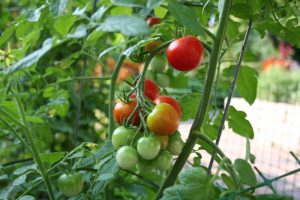 In fear that a late frost would damage young plants, I have been holding back planting my first crop of summer vegetables. Well, the gardener within has been holding back long enough! With daytime temperatures well into the 70’s and the evenings approaching 50 degrees I have planted my garden’s first wave of vegetables and herbs. My garden soil that has been ready to receive plants for weeks now and every week will see a few new plants put into the ground.
In fear that a late frost would damage young plants, I have been holding back planting my first crop of summer vegetables. Well, the gardener within has been holding back long enough! With daytime temperatures well into the 70’s and the evenings approaching 50 degrees I have planted my garden’s first wave of vegetables and herbs. My garden soil that has been ready to receive plants for weeks now and every week will see a few new plants put into the ground.
This will be the first weekend of the season that garden centers are at full plant capacity. You will find a glut of plants overflowing into parking lots and greenhouses, just waiting to be “taken home”.
As usual, the most sought-after plants of the season are tomatoes. Whether you are a first-time tomato gardener or have had some problems in the past, here are some tips for tomato harvest success.
Best Varieties –Choosing climate-appropriate varieties is a must. To guarantee crop success, be sure to select from medium-sized tomatoes like Champion, Celebrity, Early Girl, and Better Boy. Also, any of the smaller varieties like yellow pear, cherry tomatoes, and Sweet 100’s perform exceptionally well in our area. I have had great luck with the new grafted varieties, too. Because of cold night temperatures at this altitude, varieties bearing larger tomatoes tend to struggle, but with a bit more TLC it is possible to grow tomatoes “the size of your fist”.
Composted Mulch – Tomatoes enjoy a rich garden soil that drains well. Be careful not to add too much manure, which has a high content of nitrogen. Tomato plants in nitrogen-rich soil result in huge vines with little fruit. You want to starve tomatoes of nitrogen and give them plenty of phosphorus, the element indicated by the middle of the three numbers shown on a fertilizer bag. Phosphorus helps plants produce more roots and fruits, which is exactly what we want for productive tomato plants.
Nutrition Supplements – Along with compost and mulch consider turning into the soil some bone meal, 0-10-0, or super phosphate, 0-18-0. These additives encourage larger, better tasting fruits. Gypsum is also recommended to produce superior tomatoes. Gypsum is made of calcium sulfate, which reduces blossom end rot and fruits that split open. Sprinkle a little gypsum in the bottom of the planting hole, cover it with just a little dirt, then top dress with a “Tomato & Vegetable Food”.
Planting Depth – Always plant a tomato as deeply as possible. Tomatoes are one of the few plants that will root from the hairs on their vines. Prune off the side shoots and leaves from the bottom of the plant, 2-6 inches above the root ball. Then plant the vine as deeply as possible, but don’t bury any of the attached leaves. Roots will begin to grow quickly from up and down the buried stem. This will develop a larger, deeper root structure, which is exactly what a tomato plant needs to contend with the arid months of May and June.
Soil Temp – Through April daytime temperatures are warm but soils are cool; so to plant tomatoes now, we must protect the new plants and warm the soil quickly. ‘Plant Protectors’ are like individual mini-greenhouses that affordably provide these necessary protections. The water-filled tubes of these structures keep newly planted babies warm, but more importantly, they warm the soil to promote deeper, stronger root formations for this early planting.
Insider’s Scoop – Mountain tomatoes are notorious for vigorous green growth without setting blossoms, the fruits marked by black spots and blossom end rot. That’s why my home garden vines receive a little extra TLC. I prevent “spots and rot” with an easy spray regimen. Once per week I spritz my vines with alternating sprays of ‘Blossom Set’ and Bonide’s ‘Rot Stop’. Start this weekly regimen as the first blossoms show on your plants and you not only will have more fruits per vine, but the tastiest tomatoes the envy of the neighborhood. Yum!
~~ ~~ ~~ ~~ ~~ ~~ ~~
 It’s not too early to plan that special touch for Easter. A basket full of colorful springtime flowers is a beautiful symbol of rebirth. To start the planting season, garden centers mark Easter on their calendars and grow large numbers of spring/Easter floral baskets. This initial volume of stock is vast and usually offered at some of the best prices of the season.
It’s not too early to plan that special touch for Easter. A basket full of colorful springtime flowers is a beautiful symbol of rebirth. To start the planting season, garden centers mark Easter on their calendars and grow large numbers of spring/Easter floral baskets. This initial volume of stock is vast and usually offered at some of the best prices of the season.
Easter flower baskets are so affordable that they make great gifts. They are a welcome offering to let our hardworking clergy know how much we appreciate their dedicated work. Spring flower baskets are appropriate seasonal tokens for neighbors, close friends, and lonely retirees.
Until next week, I’ll see you in the garden center.

